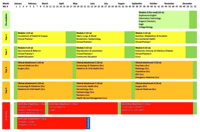
Photo from wikipedia
INTRODUCTION Education and training reforms are typically devised by accreditation bodies and rolled out nationally. This top-down approach is positioned as contextually independent, yet context is highly influential in shaping… Click to show full abstract
INTRODUCTION Education and training reforms are typically devised by accreditation bodies and rolled out nationally. This top-down approach is positioned as contextually independent, yet context is highly influential in shaping the impact of change. Given this, it is critical to consider how curriculum reform plays out as it meets local settings. We have therefore used a national-level curriculum reform process of surgical training, Improving Surgical Training (IST), to examine the influence of context in IST implementation across two UK countries. METHODS Adopting a case study approach, we used document data for contextualisation purposes and semi-structured interviews with key stakeholders across multiple organisations (n=17, plus four follow-up interviews) as our main source of data. Initial data coding and analysis were inductive. We followed this with a secondary analysis using Engeström's second generation activity theory nested within an overarching framework of complexity theory to help tease out some key elements of IST development and implementation. FINDINGS The introduction of IST into the surgical training system was historically situated within a landscape of previous reforms. IST's aims collided with existing practices and rules, thus creating tensions. In one country, the systems of IST and surgical training came together to some extent, mostly due to processes of social networks, negotiation, and leverage nested in a relatively cohesive setting. These processes were not apparent in the other country, and instead of transformative change, the system contracted. Change was not integrated, and the reform was halted. DISCUSSION Our use of a case study approach and complexity theory deepens understanding of how history, systems, and contexts interact to facilitate or inhibit change within one area of medical education. Our study paves the way for further empirical work examining the influence of context in curriculum reform, and thus determining how best to bring about change in practice.
Journal Title: Medical education
Year Published: 2023
Link to full text (if available)
Share on Social Media: Sign Up to like & get
recommendations!